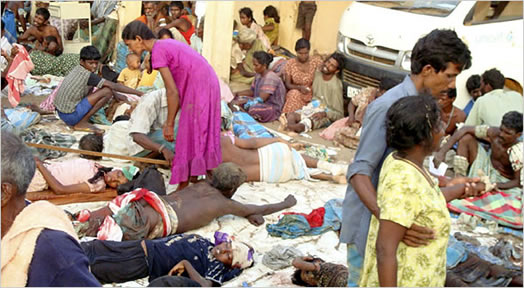Ilankai Tamil Sangam30th Year on the Web Association of Tamils of Sri Lanka in the USA |
||||
 Home Home Archives Archives |
U.N. Tells of ‘Bloodbath’ in Sri Lankaby Mark McDonald and Thomas Fuller, The New York Times, May 11, 2009
With the United Nations saying a “bloodbath” is taking place in Sri Lanka, and with the government and Tamil rebels trading accusations over the deaths of hundreds of civilians from artillery attacks, a leading group of aid agencies said Monday that both sides had shown a “wanton disregard for human life” and pressed Japan to intervene in the growing crisis. “The U.N. has consistently warned against the bloodbath scenario as we’ve watched the steady increase in civilian deaths over the last few months,” Gordon Weiss, the U.N. spokesman in Sri Lanka, said Monday. “The large-scale killing of civilians over the weekend, including the deaths of more than 100 children, shows that that bloodbath has become a reality.” A government doctor said at least 378 civilians — and perhaps as many as 1,000 — had been killed and more than 1,100 wounded on Saturday and Sunday during intensive shelling of the combat zone on Sri Lanka’s northeastern coast, a boggy sliver of beachfront where Sri Lankan troops have surrounded Tamil separatist fighters. “There were many who died without medical attention,” the doctor, V. Shanmugarajah , told The Associated Press. “Seeing the number of wounded and from what the people tell me, I estimate the death toll to be around 1,000.” Concern for civilians trapped in the zone has grown in recent weeks. The area of fighting, which at one time had been set aside by the government as a “no-fire zone,” has shrunk to about 7 square kilometers, or about 2.5 square miles. An estimated 50,000 civilians, mostly Tamils, are thought to be caught there, along with a holdout force of between 200 and 500 fighters. Some relief groups and the government have assailed the rebels for holding the civilians as human shields. Many of the same agencies and some foreign governments have accused the government of shelling the area — along with the civilians inside — despite pledges to no longer use heavy weapons, artillery or air strikes. Food, water and shelter are in short supply inside the battle zone, according to accounts from some of those who have escaped the fighting there. An official with a Catholic relief group said Monday that only one field hospital remains in operation, with doctors and medical staff fearful of leaving the bunkers where they live because of periodic shelling by the army. Meanwhile, the letter from the group of aid agencies asked Japan to demand that the U.N. Security Council formally address the Sri Lankan crisis. Until now, the council, which is to hold a ministerial-level meeting Monday in New York, has not held formal talks about the war. “We believe that Japan, a powerful player on the humanitarian stage and the largest international donor to Sri Lanka, has an important role to play in saving countless civilian lives,” the agencies said. “It is time for Japan to show that it is prepared to shoulder its responsibilities.” The letter was sent by Amnesty International, Human Rights Watch, the International Crisis Group and the Global Centre for the Responsibility to Protect. On a pro-rebel Web site Monday, the Liberation Tigers of Tamil Eelam, or L.T.T.E., accused the Sri Lankan military of having killed more than 3,200 civilians on Sunday and Monday using artillery fire, mortar barrages and heavy machine-gun attacks. The government, in a statement by the Defense Ministry, said Monday that the rebels were “bombarding their own civilians.” “Hopefully, in their calculation, this will attract the foreign countries to throw a lifeline to save their souls,” the statement said. “L.T.T.E. is desperate with the security forces closing on them. Lives of the L.T.T.E. leadership are hanging on a thread. They know they are running out of time.” Independent verification of various charges by the government and the rebels has been impossible because the military has banned journalists from the area around the war zone and from refugee camps. On Sunday, the government deported three television journalists working for Britain’s Channel 4 after they had reported on conditions in government-run refugee camps. Dr. V. Shanmugarajah, said Sunday’s attacks resulted in the worst carnage he had witnessed in the military’s intensifying campaign to wipe out the rebels. “We are doing the first aid and some surgeries as quickly as we can,” Dr. Shanmugarajah, who works from a field hospital in the combat zone, was quoted by the A.P. Press as saying. “We are doing what is possible. The situation is overwhelming; nothing is within our control.” Mr. Weiss, the U.N. spokesman, said Monday that “to the best of our knowledge, the government doctors trapped with these civilians have proven consistently reliable.” Mark McDonald reported from Hong Kong, and Thomas Fuller from Bangkok. |
|||
|
||||
